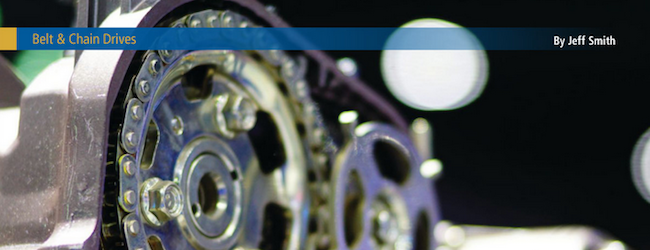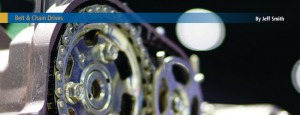
Optimizing belt and chain drive life
November 21, 2017 | By Jeff Smith

 Snow plowing a Fernie, B.C. driveway on five acres, located 15 minutes from a major ski hill is not a minor task. The massive snowfalls on some days are a three-shift strategic feat. This particular day of snowfall, I used a John Deer lawn tractor with a two-metre snow blower. The key was not to let it get too deep. With the snow that was falling I would have to clear it about four times that day. I geared up with snow pants, a heavy jacket, gloves and a toque. I easily started up the tractor and went to clear my first path. About 100-hundred-metres down the driveway the tractor stopped. Not a gradual stop, not a stop in blowing snow, just an instant stop! The snow stopped flying and the engine was no longer running. Silence. I soon realized the auger drive chain had failed and jammed between the drive gears and shock loading the system. I looked at the dry, excessively worn chain. My first thought: “Where am I going to get a new chain?” My second thought: “Some reliability expert you are – you never oiled, aligned, inspected or maintained this chain at all!” What is that they say about the cobbler’s children?
Snow plowing a Fernie, B.C. driveway on five acres, located 15 minutes from a major ski hill is not a minor task. The massive snowfalls on some days are a three-shift strategic feat. This particular day of snowfall, I used a John Deer lawn tractor with a two-metre snow blower. The key was not to let it get too deep. With the snow that was falling I would have to clear it about four times that day. I geared up with snow pants, a heavy jacket, gloves and a toque. I easily started up the tractor and went to clear my first path. About 100-hundred-metres down the driveway the tractor stopped. Not a gradual stop, not a stop in blowing snow, just an instant stop! The snow stopped flying and the engine was no longer running. Silence. I soon realized the auger drive chain had failed and jammed between the drive gears and shock loading the system. I looked at the dry, excessively worn chain. My first thought: “Where am I going to get a new chain?” My second thought: “Some reliability expert you are – you never oiled, aligned, inspected or maintained this chain at all!” What is that they say about the cobbler’s children?
Chains and belts seem to cause more trouble than they should. They are not complex, and they don’t have a multitude of integrated components, yet they seem to jump out of a multitude of reliability Pareto graphs as bad actors. In hindsight I wish I had tracked the downtime I had encountered due to “avoidable” failures of drive chains and V-belts. Having made a career of setting up inspections programs, I tend to naturally observe things as I walk through a facility. I have seen countless belts dragging on the side frames from misaligned rolls, or obviously loose drive belts flapping happily until failure. Why?
As with many assets, let’s consider the key stages that impact reliability: Selection, Storage, Installation, Operation, Maintenance and Disposal.
Selection
In many cases the selection of a drive chain or belt has been made by the manufacturer; but, to follow RCM logic, your operating context may differ, therefore your chain or belt may not be adequate for the current loading you are experiencing. (Loading could be under-loading, overloading, shock loading or environmental loading.) To select a chain or belt the following must be understood:
1) What is the horsepower that is going to be transmitted? And, what is a realistic service factor? If the system will be subject to hard stops and starts or intermittent overloading, we need to include a service factor in our calculations.
Service factor x required horsepower = design HP
An example of a service factor would be an AC motor driving a centrifugal pump continuously would use a service factor of 1.2.
Note: Use your supplier’s subject matter experts; they will help.
2) What is the required ratio between drive and driven? Remember, in belt systems, it is only theoretical as slippage will happen. So over-speeding slightly is a good practice. This does not apply to chain drives.
Selecting the right drive is imperative not only for initial construction but should be revisited if drive or driven speeds or loads have changed. If it is a problem drive, one of the first considerations should be: Can this drive handle what we want it to do? (CAN>WANT).
Storage
Value destruction can and does happen in storage, it is often driven by moisture, dust, sunlight, chemical attack, mechanical damage or mislabelling. When storing chains or belts, keep them in a clean, dry area. Do not mishandle them. Try to limit the stock needed on hand when Min/Max quantities are automated. I have seen scenarios where there is a drive issue that requires the use of multiple belts in a short time, but once the issue is resolved, the stock levels have been driven up and the storeroom ends up with a 10-year supply of belts. There is also the fire sale mentality that dictates the purchase of chain in bulk “because it was such a deal!” Store what is actually needed and take care of it. As with any parts, ensure your BOM (Bill of materials) is correct for the assets; slight pitch differences can be easily overlooked and create chain-eating machines.
Installation
How tight is tight? Deviation tribal wisdom provide an astounding number of answers to this question: ½” deflection per foot; you should be able to twist the belt over; there should be no chain sag at all, etc. But let’s start the installation at the beginning.
- Inspect the driven shaft and look for any deformation or cracks in the key slot using magnetic particle inspection, if possible. Look for any signs of torsional stress. Is the shaft worn? Use your calipers and check the fit between the shaft and the sheave/sprocket. Remember, drives should last for years; take the time to ensure a proper fit. Also check the key slot, with the new key of correct hardness. Remember to balance; fill half the exposed key slot with the key.
- Install the drive sheave or gear in a position that centres it. I have seen way to many guards worn through. If it is a key and set screw, tighten it correctly. If it’s a taper lock, make sure it has sufficient contact. Prussian bluing isn’t just for hard-hat liners.
- Follow steps one and two for the driven sheave/sprocket, then align them. There is a multitude of belt or chain alignment tools on the market, so don’t use guesswork here.
- Install the drive belt/chain and tighten. How tight? I will let you in on a little secret: there is no definitive answer. I have had different settings from two manufacturers for the same drive system. Some systems are not sensitive to tightness but for other systems it’s critical. If you are the purchaser, have the suppliers SME give you specifications for how tight the drive should be and any special instructions for installation. If you’re the planner, translate the tightening instructions into the job plan. If you’re the tradesman, read and follow the instructions. One last thing: Do not close the jobs until the run in retightening has been done. Installing drives is worth doing right.
Operation
If possible, try to avoid shock loading the drive systems. In many cases this can be accomplished with automation and control. For example, soft starts or fluid clutches. Ensure the systems are controlled to avoid loaded starts. If you have a problem drive system that keeps failing and with no mechanical issue, investigate the system loading. Also ensure your process has sequential start-ups, starting from the last machine first.
Maintenance
The first requirements in maintaining drive systems is to retighten or inspect after installation. Things do stretch and wear in. This is a simple but often overlooked task. As the drive system progresses through its life, make sure the criteria that are life limiting is understood, such as the limiting acceptable pitch increase between pins or acceptable wear measurements for belts. If we define the criteria that establishes end of life we can maintain prior to failure. Follow the drives specifications for lubrication type and method.
I utilize dynamic inspections for belts and chains. The drive system must have a guard but if the guard is fully enclosed, plants tend to run the drive to failure. We don’t fix what we can’t see. Use doors or expanded metal windows to enable dynamic inspections. Dynamic drive inspections are conducted with a strobe light slightly offset to the belt/chain pass frequency. This enables a very clear view of each inch or link. Inspect belts for cuts, glazing, separation, contamination and wear. Inspect chains for roller damage, evidence of side loading (worn sprocket sides), elongation, contamination, adequate lubrication and wear.
Another key point in drive-system maintenance is the fact that many drive-system failures are not associated with the drive system itself. As the system is inspected, look for evidence of leaking seals or process spills on the drive. Inspect for mounting looseness or excessive movement of the drive and driven units. Ensure there is adequate housekeeping around the system and don’t be surprised if a drive buried in woodchip fails.
Disposal
In reliability improvement projects, asset disposal is a consideration. Do we use parts? Do we run out assets by allowing degradation? You get the picture. So what would I have to say about simple drive system disposal? Dispose the used stuff! How many of you have an old fan belt for emergencies? (Okay, that may just be old guys like me). Don’t keep old parts for emergencies if you feel you need replacements – stock new parts. It’s not worth the downtime to reuse a worn belt or sheave. I have seen some cases where disassembling requires substantial effort, so an extra set of belts are placed over the rotating assembly to speed replacement. If following best practices, replacing them like this is unnecessary. But if you sleep better with them there, make sure they are protected from the elements and secured.
Jeff Smith is a reliability subject matter expert and the owner of 4TG Industrial. His work spans a cross section of industries, including oil sands, mining, pulp and paper, packaging, petrochemical, marine, brewing, transportation and synfuels. Reach him at smith@4tg-ind.ca.
